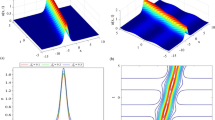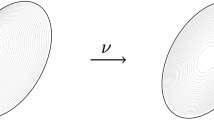Abstract
Controlled disturbances are inserted into the wind tunnel flow, and probing measurements of the fields of the amplitudes of pressure and phase velocity oscillations of these disturbances are performed. Based on the relations for inviscid interaction of long-wave vortex, entropy, and acoustic disturbances with the shock wave on a wedge and numerical simulations, the coefficients of conversion of various modes to pressure oscillations on the model surface are determined for the test conditions of a supersonic flow in the T-327B blowdown wind tunnel located at the Khristianovich Institute of Theoretical and Applied Mechanics of the Siberian Branch of the Russian Academy of Sciences. The method of mode decomposition for controlled disturbances with the use of disturbance conversion coefficients is implemented in the case of a flat plate model with a sharp leading edge aligned at different angles of attack and side-slip in the flow.
Similar content being viewed by others
References
S.A. Gaponov and A.A. Maslov, Development of Disturbances in Compressible Flows, Nauka, Novosibirsk, 1980.
V.N. Zhigulev and A.M. Tumin, Onset of Turbulence, Nauka, Novosibirsk, 1987.
L.S.G. Kovasznay, Turbulence in supersonic flow, J. Aeronautical Sci., 1953, Vol. 20, No. 10, P. 657–674.
V.A. Lebiga, V.N. Zinoviev, and A.Yu. Pak, Using a hot-wire anemometer for measurement of characteristics of a random acoustic field in compressible flows, J. Appl. Mech. Tech. Phys., 2002, Vol. 43, No. 3, P. 488–492.
J. Weiss, H. Knauss, and S. Wagner, Experimental determination of the free-stream disturbance field in a short-duration supersonic wind tunnel, Experiments in Fluids, 2003, Vol. 35, P. 291–302.
M.V. Morkovin, Fluctuations and hot-wire anemometry in compressible flows, RTO/STO Technical Report AGARD-AG-24, AGARDograph, NATO AGARD, 1956. ISSN: 0365–2467.
I.S. Tsyryulnikov, S.V. Kirilovskiy, and T.V. Poplavskaya, Numerical simulation of interaction of long-wave disturbances with a shock wave on a wedge for the problem of mode decomposition of supersonic flow oscillations, in: AIP Conf. Proceedings, 2016, Vol. 1770, P. 030040–1–030040–7.
P.W. Duck, D.G. Lasseigne, and M.Y. Hussaini, On the interaction between the shock wave attached to a wedge and freestream disturbance, Theor. Comp. Fluid Dyn., 1995, Vol. 7, P. 119–139.
P.W. Duck, D.G. Lasseigne, and M.Y. Hussaini, The effect of three-dimensional freestream disturbances on the supersonic flow past a wedge, ICASE Report No. 97-26, 1997, P. 1–32.
I.S. Tsyryulnikov, S.V. Kirilovskiy, and T.V. Poplavskaya, Coefficients of transformation of long-wavelength perturbations of a supersonic incident flow around a wedge into pressure fluctuations on its surface, Techn. Phys. Letters, 2016, Vol. 42, P. 1094–1098.
I.S. Tsyryulnikov, S.V. Kirilovskiy, and T.V. Poplavskaya, Interaction of long-wave perturbations with a shock wave on a wedge and method of mode decomposition of supersonic flow pulsations, J. Physics: Conf. Series, 2017, Vol. 894, P. 012103–1–012103–7.
S.V. Kirilovskiy, T.V. Poplavskaya, I.S. Tsyryulnikov, and A.A. Maslov, Evolution of disturbances in the shock layer on a flat plate in the flow of a mixture of vibrationally excited gases, Thermophysics and Aeromechanics, 2017, Vol. 24, No. 3, P. 421–430.
I.S. Tsyryulnikov and S.G. Mironov, Wave field of controllable periodic disturbances generated by two sources, Thermophysics and Aeromechanics, 2005, Vol. 12, No. 3, P. 353–360.
I.S. Tsyryulnikov, A.A. Maslov, S.G. Mironov, T.V. Poplavskaya, and S.V. Kirilovskiy, The efficiency of the method of sound-absorbing coatings in vibrationally excited hypersonic flow, Techn. Phys. Letters, 2015, Vol. 41, P. 184–186.
Author information
Authors and Affiliations
Corresponding authors
Additional information
This work was financially supported by the Russian Science Foundation (Grant No. 19-71-00031).
Rights and permissions
About this article
Cite this article
Tsyryulnikov, I.S., Gromyko, Y.V. & Poplavskaya, T.V. Mode decomposition of disturbances in a supersonic flow. Thermophys. Aeromech. 27, 643–653 (2020). https://doi.org/10.1134/S0869864320050029
Received:
Revised:
Accepted:
Published:
Issue Date:
DOI: https://doi.org/10.1134/S0869864320050029




